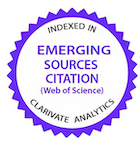Perfil fermentativo, valor nutricional e estabilidade aeróbia de silagens mistas de capim-elefante e cunhã
DOI:
https://doi.org/10.1590/1809-6891v25e-76994EResumo
Objetivou-se avaliar o efeito da inclusão de cunhã na dinâmica fermentativa, qualidade nutricional e estabilidade aeróbia de silagens mistas de capim-elefante. Níveis de cunhã (0, 20, 40, 60 e 80% na matéria natural) foram adicionados às silagens de capim-elefante. Adotou-se o delineamento inteiramente casualizado, com 5 tratamentos e 3 repetições, totalizando 15 silos experimentais, que foram abertos após 30 dias de fermentação. A inclusão de cunhã nas silagens de capim- lefante resultou em efeito quadrático para permeabilidade, densidade, pH máximo, pH final, tempo para atingir a temperatura máxima e estabilidade aeróbia (P<0,05). Níveis de inclusão de cunhã aumentaram a recuperação de matéria seca, pH, matéria seca, matéria orgânica, extrato etéreo, proteína bruta e nutrientes digestíveis totais (P<0,001) e reduziram as perdas por gases e efluentes, matéria mineral, fibra em detergente neutro, fibra em detergente ácido, hemicelulose, celulose, lignina e carboidratos totais (P<0,001). As inclusões de 40, 60 e 80% de cunhã proporcionaram aumentos de temperatura às 10, 20, 30 e 40 horas. A inclusão de cunhã em teores de até 80% reduz as perdas na fermentação, permite incremento nutricional e aumento da estabilidade aeróbica das silagens.
Downloads
Referências
Amaral RC, Carvalho BF, Costa DM, Morenz MJF, Schwan RF, Ávila CLS. Novel lactic acid bacteria strains enhance the conservation of elephant grass silage cv. BRS Capiaçu. Anim. Feed Sci. Techn. 2020;264:e114472. https://doi.org/10.1016/j.anifeedsci.2020.114472
Araújo JS, Araújo CA, Macedo A, Silva CS, Novaes JJS, Lima DO, Borges EN, Gois GC, Araújo GGL, Campos FS. Fermentation dynamics, nutritional quality, and heating capacity of mixed silages of elephant grass (Pennisetum purpureum Schum) and leucaena (Leucaena leucocephala). Braz. J. Vet. Res. Anim. Sci. 2022;59:e189466. https://doi.org/10.11606/issn.1678-4456.bjvras.2022.189466
Bezerra HFC, Santos EM, Oliveira JS, Carvalho GGP, Pinho RMA, Silva TC, Pereira GA, Cassuce MR, Zanine AM. Fermentation characteristics and chemical composition of elephant grass silage with ground maize and fermented juice of epiphytic lactic acid bacteria. South Afr. J. Anim. Sci. 2019;49(3):522-533. https://doi.org/10.4314/sajas.v49i3.13
Matias AGS, Araujo GGL, Campos FS, Moraes SA, Gois GC, Silva TS, Emerenciano Neto JV, Voltolini TV. Fermentation profile and nutritional quality of silages composed of cactus pear and maniçoba for goat feeding. J. Agric. Sci. 2020;158(1):304–312. https://doi.org/10.1017/S0021859620000581
Zanine AM, Sene OA, Ferreira DJ, Parente HN, Parente MOM, Pinho RMA, Santos EM, Nascimento TVC, Lima AGVO, Perazzo AF, Portela YN, Bandeira DM. Fermentative profile, losses and chemical composition of silage soybean genotypes amended with sugarcane levels. Sci. Rep. 2020; 10:e21064. https://doi.org/10.1038/s41598-020-78217-1
Macêdo AJS, Neto JMC, Silva MA, Santos EM. Potencialidades e limitações de plantas forrageiras para ensilagem: Revisão de Literatura. Rev. Bras. Hig. Sanid. Anim. 2021;13(1):320-337. http://dx.doi.org/10.5935/1981-2965.20210010
Machado HC, Campos NM, Santos CAP. Análise do desenvolvimento e da produção da cunhã em função de diferentes tipos de adubação orgânica. Ci. Agríc. 2021;19(1):25-36. https://doi.org/10.28998/rca.v19i1.10265
Lemos MF, Mello ACL, Guim A, Cunha MV, Silva PHF, Atroch TMA, Simões Neto DE, Oliveira Neto PM, Medeiros AS, Clemente JVF. Grass size and butterfly pea inclusion modify the nutritional value of elephant grass silage. Pesq. Agropec. Bras. 2021;56:e02409. http://dx.doi.org/10.1590/S1678-3921.pab2021.v56.02409.
Multisona RR, Shirodkar S, Arnold M, Gramza-Michalowska A. Clitoria ternatea flower and its bioactive compounds: potential use as microencapsulated ingredient for functional foods. Appl. Sci. 2023;13:e2134. http://dx.doi.org/10.3390/app13042134
Alvares CA, Stape JL, Sentelhas PC, Gonçalves JLM, Sparovek G. Köppen’s climate classification map for Brazil. Met. Zeitschrift. 2013;22(1):711-728. http://dx.doi.org/10.1127/0941-2948/2013/0507
Atalay H, Bilal T, Ekiz B. The effect of physically effective neutral detergent fiber on milk composition and milk yield. Etlik Vet. Mikrob. Derg. 2021;32(2):140-144. http://dx.doi.org/10.35864/evmd.1015773
Jobim CC, Nussio LG, Reis RA, Schmidt P. 2007. Avanços metodológicos na avaliação da qualidade da forragem conservada. Rev. Bras. Zootec. 36:101–119. http://dx.doi.org/10.1590/S1516-35982007001000013
Williams AG. The permeability and porosity of grass silage as affected by dry matter. J. Agric. Eng. Res. 1994; 59(2):133-140. https://doi.org/10.1006/jaer.1994.1070
Aoac. Association of Official Analytical Chemists. Official methods of analysis, 20th ed. Washington, D.C.: Latimer Jr., G.W.; 2016. 3172p.
Mizubuti IY, Pinto AP, Pereira ES, Ramos BMO. Métodos laboratoriais de avaliação de alimentos para animais, 1st ed. Londrina, PR: Eduel; 2009. 228p.
Kung Junior L. Microbial and chemical additives for silage: effect on fermentation and a animal response. Proceedings of the II Workshop Sobre Milho Para Silagem, Piracicaba, Brazil, July 2000. p. 1–53.
Araújo CA, Santos APM, Monteiro CCF, Lima DO, Torres AM, Santos CVS, Silva JJ. Efeito do tempo de ensilagem sobre a composição química, perfil fermentativo e estabilidade aeróbia de silagens de milho (Zea mays). Div. J. 2020;5(1):547-561. http://dx.doi.org/10.17648/diversitas-journal-v5i1-1035.
Tao X, Ji C, Chen S, Zhao J, Wang S, Li J, Sun F, Shao T. Fermentation quality and aerobic stability of Napier grass ensiled with citric acid residue and lactic acid bacteria. Trop. Grassl. Forrajes Trop. 2021;9(1):52-9. http://dx.doi.org/10.17138/tgft(9)52-59.
Aocs. American Oil Chemists' Society. Official methods and recommended practices, 7th ed. Urbana, IL; 2017.
Van Soest PJ, Robertson JB, Lewis BA. Methods for dietary fiber, neutral detergent fiber, and non starch polysaccharides in relation to animal nutrition. J. Dairy Sci. 1991;74:3583-3597. http://dx.doi.org/10.3168/jds.S0022-0302(91)78551-2
Sniffen CJ, O'Connor JD, Van Soest PJ, Fox DG, Russell JB. A net carbohydrate and protein system for evaluating cattle diets: II. Carbohydrate and protein availability. J. Anim. Sci. 1992;70(11):3562-3577. http://dx.doi.org/10.2527/1992.70113562x
Hall MB. Challenges with non-fiber carbohydrate methods. J. Anim. Sci. 2003;81(12):3226-32. http://dx.doi.org/10.2527/2003.81123226x. PMid:14677880
Undersander D, Mertens DR, Thiex N. Forage analysis procedures. Omaha: National Forage Testing Associaton, 1993. 154 p.
Dias ECB, Cândido MJD, Furtado RN, Pompeu RCFF, Silva LV. Nutritive value of elephant grass silage added with cottonseed cake in diet for sheep. Rev. Ci. Agron. 2019;50(2):321-328. http://dx.doi.org/10.5935/1806-6690.20190038.
Carvalho IQ, Jobim CC, Osmari MP, Daniel JLP. Occurrence of visible losses and relationship with corn silage management in dairy farms in the State of Paraná. Acta Sci. Anim. Sci. 2021;43:e49933. http://dx.doi.org/10.4025/actascianimsci.v43i1.49933
Borreani G, Tabacco E, Schmidt RJ, Holmes BJ, Muck RE. Silage review: Factors affecting dry matter and quality losses in silages. J. Dairy Sci. 2018;101(5):3952–3979 https://doi.org/10.3168/jds.2017-13837
Almeida BAS, Teixeira FA, Nunes TSS, Gois GC, Reis LO, Ferreira Filho PA, Ramos RJN, Rodrigues AC, Menezes DR, Silva AM, Silva SFA, Queiroz MAA. Fermentative dynamics and nutritional characteristics of mixed corn silages with and without cobs associated with butterfly pea hay. New Zealand J. Agric. Res. 2023;66:1-18. https://doi.org/10.1080/00288233.2023.2233456
Randby AT, Halvorsen HN, Bakken AK. Losses and grass silage quality in bunker silos compacted by tractor versus wheel loader. Anim. Feed Sci. Techn. 2020;266:e114523. http://dx.doi.org/10.1016/j.anifeedsci.2020.114523
Costa ER, Mello ACL, Guim A, Costa SBM, Abreu BS, Silva PHF, Silva VJ, Simões Neto D. Adding corn meal into mixed elephant grass–butterfly pea legume silages improves nutritive value and dry matter recovery. J. Agric. Sci. 2022;160:185-193. http://dx.doi.org/10.1017/S0021859622000284
Ren X, Tian H, Zhao K, Li D, Xiao Z, Yu Y, Liu F. Research on pH value detection method during maize silage secondary fermentation based on computer vision. Agric. 2022;12:e1623. http://dx.doi.org/10.3390/agriculture12101623
Şenyüz Η, Karsli Μ. Digestibility and silage quality of potato pulp silages prepared with different feedstuff. J. Hellenic Vet. Med. Soc. 2022;72:3383–3390. http://dx.doi.org/10.12681/jhvms.29381
Dong Z, Li J, Wang S, Dong D, Shao T. Time of day for harvest affects the fermentation parameters, bacterial community, and metabolic characteristics of sorghum-sudangrass hybrid silage. mSphere. 2022;31:e0016822. https://doi.org/10.1128/msphere.00168-22
Kung Jr L, Savage RM, Silva EB, Polukis SA, Smith ML, Johnson ACB, Miller MA. The effects of air stress during storage and low packing density on the fermentation and aerobic stability of corn silage inoculated with Lactobacillus buchneri 40788. J. Dairy Sci. 2021;104(4):4206–4222. http://dx.doi.org/10.3168/jds.2020-19746
Li YF, Wang LL, Jeong EC, Kim HJ, Ahmadi F, Jong Geun Kim JG. Effects of sodium diacetate or microbial inoculants on aerobic stability of wilted rye silage. Anim. Biosci. 2022;35(12):1871-1880. http://dx.doi.org/10.5713/ab.22.0150
Nascimento RR, Edvan RL, Nascimento KS, Barros LS, Bezerra LR, Miranda RS, Perazzo AF, Araújo MJ. Quality of silage with different mixtures of melon biomass with urea as an additive. Agron. 2023;13:e293. http://dx.doi.org/10.3390/agronomy13020293
Camilo MG, Fernandes AM, Processi EF, Motta OV, Roseira JPS, Oliveira TS. Evaluation of the type of silo associated or not with additives on the nutritional value, aerobic stability, and microbiology of pearl millet silage. An. Acad. Bras. Ci. 2023;95:e20210421. http://dx.doi.org/10.1590/0001-3765202320210421
McDonald P, Henderson AR, Heron SJE. The biochemistry of silage. 2nd ed. Marlow: Chalcomb Publishing. 1991; 340p.
Araújo, CA, Novaes JJS, Araújo JS, de Macedo A, Silva CS, Silva TC, Emerenciano Neto J, Araújo GGL, Campos FS, Gois GC. Perfil fermentativo, calidad nutricional y estabilidad aerobia de ensilajes mezclados de hierba elefante (Pennisetum purpureum Schum) y maní forrajero (Arachis pintoi). Rev. MVZ Córdoba. 2022;27(3):e2549. https://doi.org/10.21897/rmvz.2549
Marques KO, Jakelaitis A, Guimarães KC, Pereira LS. Perfil agronômico, fermentativo e bromatológico da silagem obtida do consórcio entre milho e soja. Res. Soc. Dev. 2021;10(1): e41410111925. http://dx.doi.org/10.33448/rsd-v10i1.11925
Rodrigues WM, Sales ECJ, Monção FP, Marques OFC, Rigueira JPS, Pires DAA, Rufino LDA, Rocha Junior VR, Alves DD, Gomes, VM. J. Dev. 2020;6(4):22001-22017. http://dx.doi.org/10.34117/bjdv6n4-389
Amorim DS, Edvan RL, Nascimento RR, Bezerra LR, Araújo MJ, Silva AL, Mielezrski F, Nascimento KS. Fermentation profile and nutritional value of sesame silage compared to usual silages. Italian J. Anim. Sci. 2020;19(1):230-239. http://dx.doi.org/10.1080/1828051X.2020.1724523.
Nascimento KS, Edvan RL, Vallecillo SJA, Nascimento RR, Barros DMA, Silva MA, Araújo MJ, Bezerra LR. Can fermentative and nutritional quality of Panicum maximum silage be improved with the use of corn silage juice as a bioinoculant? Int. J. Agric. Biol. 2021;26(3): 411-419. https://doi.org/10.17957/IJAB/15.1850
Borges EN, Araújo CA, Monteiro BS, Silva AS, Albuquerque LF, Araújo GGL, Campos FS, Gois GC, Souza RC, Araújo AO. Buffel grass pre-dried as a modulator of the fermentation, nutritional andaerobic stability profile of cactus pear silage. New Zealand J. Agric. Res. 2023;66:1-16. https://doi.org/10.1080/00288233.2023.2212173
Carrillo-Díaz MI, Miranda-Romero LA, Chávez-Aguilar G, Zepeda-Batista JL, González-Reyes M, García-Casillas AC, Tirado-González DN, Tirado-Estrada G. Improvement of ruminal neutral detergent fiber degradability by obtaining and using exogenous fibrolytic enzymes from white-rot fungi. Anim. 2022;12:e843. http://dx.doi.org/10.3390/ani12070843.
Hawu O, Ravhuhali KE, Mokoboki HK, Lebopa CK, Sipango N. Sustainable Use of legume residues: effect on nutritive value and ensiling characteristics of maize straw silage. Sustain. 2022;14(11):e6743. https://doi.org/10.3390/su14116743
Van Soest PJ. Nutritional ecology of the ruminant. 2th ed. Ithaca: Cornell University Press. 1994; 476p.
Gülümser E, Mut H, Başaran U, Doğrusöz MÇ. Na assessment of ensiling potential in maize x legume (soybean and cowpea) binary mixtures for yield and feeding quality. Turkish J. Vet. Anim. Sci. 2021;45(3):547-555. https://doi.org/10.3906/vet-2006-43
Souza WF, Costa KAP, Guarnieri A, Severiano EC, Silva JT, Teixeira DAA, Oliveira SS, Dias MBC. Production and quality of the silage of corn intercropped with Paiaguas palisadegrass in different forage systems and maturity stages. Rev. Bras. Zootec. 2019;48: e20180222. https://doi.org/10.1590/rbz4820180222
Weimer PJ. Degradation of cellulose and hemicellulose by ruminal microorganisms. Microorg. 2022;10:e2345. http://dx.doi.org/10.3390/microorganisms10122345
Downloads
Publicado
Como Citar
Edição
Seção
Licença
Copyright (c) 2024 Ciência Animal Brasileira / Brazilian Animal Science

Este trabalho está licenciado sob uma licença Creative Commons Attribution 4.0 International License.
Autores que publicam nesta revista concordam com os seguintes termos:
- Autores mantém os direitos autorais e concedem à revista o direito de primeira publicação, com o trabalho simultaneamente licenciado sob a Licença Creative Commons Attribution que permite o compartilhamento do trabalho com reconhecimento da autoria e publicação inicial nesta revista.
- Autores têm autorização para assumir contratos adicionais separadamente, para distribuição não-exclusiva da versão do trabalho publicada nesta revista (ex.: publicar em repositório institucional ou como capítulo de livro), com reconhecimento de autoria e publicação inicial nesta revista.
- Autores têm permissão e são estimulados a publicar e distribuir seu trabalho online (ex.: em repositórios institucionais ou na sua página pessoal) a qualquer ponto antes ou durante o processo editorial, já que isso pode gerar alterações produtivas, bem como aumentar o impacto e a citação do trabalho publicado (Veja O Efeito do Acesso Livre).






























